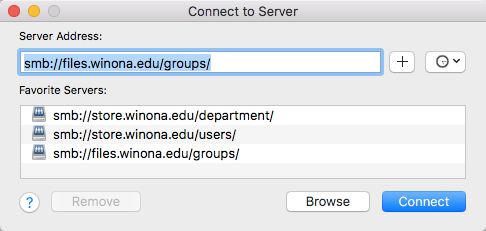Virtual private network for employees
| REVISION IN PROGRESS: This article contains useful information, but is being revised to reflect recent updates. Direct questions to TLT (tlt@winona.edu). |
Winona State University Information Technology Services provides a secure virtual private network for employees working from off-campus locations. To maintain data security, access to some online systems and services requires a direct connection to our private campus network. Using our virtual private network (VPN), employees working remotely can emulate this direct, private connection and access these services as if they were on campus. Most employees do not need a continuous VPN connection when working remotely. Employees cannot establish a VPN connection using a personally-owned device and must use multi-factor authentication to verify their credentials when connecting to our VPN.
Setting up VPN
Step 1: Install an authenticator app
Winona State University Information Technology Services supports two authenticator apps for use with our VPN:
- Microsoft Authenticator (recommended): Install this app if you prefer using your phone or tablet to verify your VPN credentials.
- Authy: Install this app if you prefer using your WSU laptop to verify your VPN credentials.
Step 2: Add your VPN account to your authenticator app
Please use Google Chrome to complete this step. There are known issues with other browsers. This step must be completed while on the Winona or Rochester campus. If using a Winona State University laptop, you must be connected to the Wazoo wireless network. You can also complete this step using your office desktop with a secure wired network connection.
- If using a laptop, ensure that it's connected to the Wazoo wireless network wireless network
- Use Chrome to go to the VPN enrollment site at https://otp.winona.edu
- Select the link, "Proceed to set up my StarID for campus VPN access"
- Enter your StarID (e.g., ab1234cd) in the Username field and select Submit
- Enter your StarID password and select Submit
- Click the Add OAUTH Token button
- Click the radio button next to Online then click Add. You will be presented with a QR code and a manual code.
- Open your authenticator app. If using Microsoft Authenticator on your phone or tablet, tap Add Accounts, then Work or School account. The app will ask for permission to use your camera, tap Allow. Then, use your phone to scan the QR code on your computer screen. Your account will be added to the app. If you are using Authy, select the "+" icon, copy and paste the manual account code from the VPN enrollment screen to the field in Authy, and select the Add Account button.
- IMPORTANT: Select the Done button on your computer screen to complete the enrollment process.
- Close and reopen your authenticator to ensure that the Winona online account was added. You will use the rolling code for that account to verify your VPN credentials. Note that you may have other accounts listed in your authenticator app with their own rolling codes.
Step 3: Test your VPN connection
You can now test your VPN connection from off-campus. You can also test it using your laptop while on campus if you are connected to the Eduroam wireless network. To log in to Eduroam, use the StarID@minnstate.edu format of your username and do not enable the connection to reconnect automatically.
How do I access my network storage off-campus?
You will first need to connect to your VPN client Cisco AnyConnect. Next follow steps below:
Windows 10
- Open your Start Menu and click the "Click to Map Network Drives" tile located at the top middle of the screen
- Re-open your Start Menu and click the "File Explorer" tile in the middle of the screen
- Your network storage drives will be located under the "Network locations" heading. You may have to scroll down to find it.
macOS
- In Finder, press and hold the <Command> key then tap the <K> key to bring up the "Connect to Server" prompt
- Connect to one of the network locations listed in Fig 2.
- Just copy/paste one of the addresses below if your list is not pre-populated
- Personal storage: smb://store.winona.edu/users/
- Department drive: smb://store.winona.edu/department/
